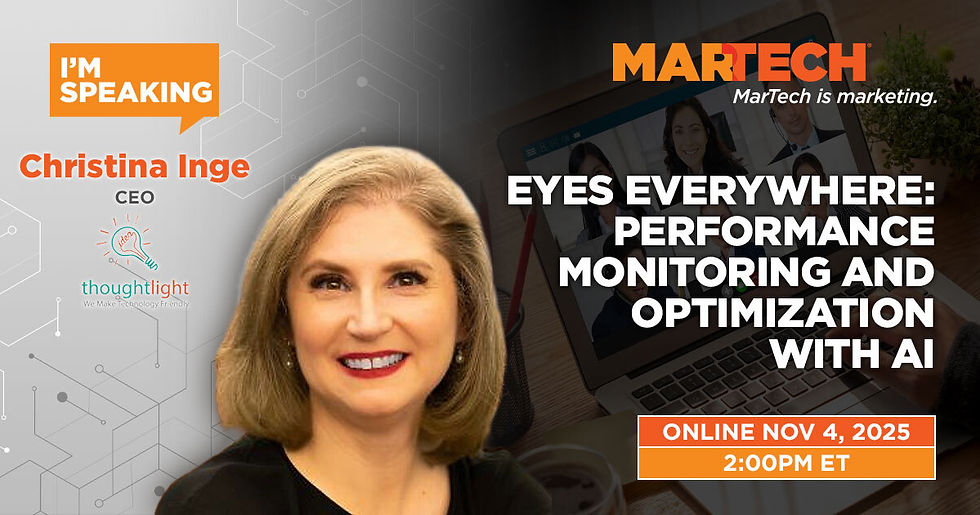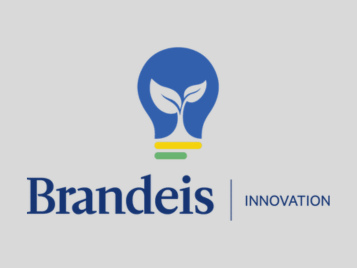What I Learned Speaking at MarTech: Why Perfect Data Beats Fancy AI Every Time
- christina5443
- Nov 12
- 5 min read
Updated: Nov 13

Last week, I had the privilege of joining a panel at the MarTech conference on "Eyes Everywhere: Performance Monitoring and Optimization with AI," alongside Anthony Tedesco from Cisco and Reza Moyenden from Salt Agency. Our moderator Sarah Owens from ARS X Machina asked the tough questions, and the conversation revealed something critical: most marketers are optimizing for the wrong things—or not optimizing at all.
The Data vs. AI Dilemma
We kicked off with a provocative question: Would you rather have perfect data with no AI, or messy data with AI tools?
My answer was immediate: Perfect data, no AI.
Here's why: If you have AI working with messy data, you're just going to make terrible mistakes very quickly and efficiently. AI accelerates whatever you feed it. Garbage in, garbage out—but now at scale and speed.
But here's the paradox I also called out: No organization has perfect data. And waiting for perfect data can become its own form of paralysis. You can get so obsessed with having absolutely pristine datasets that you never take action. And inaction? That's choosing bad performance. That's leaving money on the table. That's ceding market share to competitors who are taking a more proactive approach.
The key is finding the balance—good enough data with strategic human oversight, not blind faith in automation.
When Everyone Optimizes, Who Wins?
One question that resonated with the audience: What happens when everyone is optimizing in real time with AI? Is there a ceiling to performance?
Yes, optimization becomes table stakes. But that doesn't mean you shouldn't do it.
The differentiator isn't that you're optimizing—it's who you're optimizing for. If you're a niche organic food brand serving gluten-free, allergy-conscious, sustainability-focused customers, your optimization goes deeper into that blue ocean. You're not competing on the same metrics as everyone else. You're serving your specific audience better than anyone else can.
This is where AI can deepen your competitive advantage rather than erode it: by helping you get more precise about serving the customers who need your solution most.
The Agentic AI Warning: Humans Must Stay in the Loop
This was a big one for me, and I shared a real example from our work at Thoughtlight.
We recently deployed an agentic AI automation for a client—data cleaning followed by automated outreach. Sounds efficient, right? Except the automation removed completely valid contacts from the workflow. Key stakeholders never received critical messages because we tried to take humans out of the loop.
Agentic AI is engineered to remove humans from decision-making. And AI is notoriously bad at making decisions about people.
We course-corrected immediately, but it was a valuable (and humbling) lesson. Even when you're dealing with data—where AI is supposed to be at its most accurate—you need humans verifying segmentation, creative, execution, and outcomes. At multiple touchpoints. Every time.
The Metric Nobody's Tracking (But Should Be)
When asked what performance signal will be critical in five years that we're ignoring today, my answer was clear: Customer Lifetime Value (CLV).
Too many brands are still obsessing over vanity metrics and short-term campaign ROI. They're celebrating a campaign that drove high conversion rates without asking: What's the lifetime value of those customers? Were they on-target or off-target?
You might run a deeply discounted promotion that drives a ton of sales, but if those customers churn after one purchase, you've just bought yourself a bunch of unprofitable transactions. With better predictive models and AI-powered visibility into customer journeys, we'll look back in five years and wonder how we ever made decisions without CLV tracked back to channel and audience segment.
The First-Mover Advantage in GEO Is Happening Right Now
Here's the urgent message I delivered: If you're not optimizing for AI-powered search right now, you're already behind.
Just like with traditional SEO in the early 2000s, there's a first-mover advantage happening in Generative Engine Optimization (GEO). Whoever shows up in AI-generated answers now—and gets positive user feedback—will keep showing up in future answers. The algorithms learn. They reinforce.
ChatGPT, Perplexity, Claude, Gemini—these tools love structured data, schema markup, and accessible content. Invest in these now:
Schema markup (especially FAQ and How-To schema)
Website accessibility (it's driving both SEO and GEO)
Question-based content (not just keyword-based)
Use tools like SEMrush to identify the questions your audience is actually asking, then create content that answers those questions across multiple channels: your site, social media, video (especially YouTube), and traditional search.
Questions Beat Keywords in the AI Era
This was my final tactical takeaway for the audience:
Stop optimizing for keywords. Start optimizing for questions.
AI-driven search is conversational. People aren't typing "email marketing best practices"—they're asking "How do I improve my email open rates?" or "What's the best email marketing tool for small businesses?"
Identify those questions through SEO research, then use generative AI tools to create content that directly answers them. Structure it with clear headings, FAQ blocks, comparison tables, and lists. Make it scannable for both humans and machines.
The K-Shaped Economy Insight
One audience question hit differently: What are you changing in this current K-shaped economy?
My answer: We're doubling down on GEO.
It's the quickest way to build long-term value. While others chase short-term wins, smart brands are investing in the infrastructure that will pay off for years. Schema markup, structured content, accessibility—these aren't quick fixes. But they create compound advantages.
By May 2026, Reza shared data suggesting ChatGPT will hit mass adoption. If you're not ready by then, you'll be scrambling to catch up with competitors who got there first.
What This Means for You
The panel reinforced something I've been preaching for months: The rules changed. The question is whether you're still playing by the old ones.
If your organization is part of the 60% (according to our poll) not yet leveraging AI to monitor and optimize campaigns, start small:
Set up anomaly detection alerts
Audit your schema markup
Identify the top 10 questions your audience is asking
Track LLM traffic to your site (check your server logs or use Cloudflare)
Test AI tools with human oversight—never remove humans from the loop
And if you want to learn how to build custom tools without a developer or a massive budget, join me for the Vibe-Coding workshop on November 14. It's exactly the kind of practical, hands-on skill that separates marketers who adapt from those who get left behind.
The transformation isn't coming. It's here. The only question is: Are you ready?Christina Inge, EdD, is CEO of Thoughtlight and a marketing strategist specializing in AI-driven search optimization. She's trained 500+ professionals and teaches marketers how to thrive in the age of GEO, LLMO, and agentic AI.How's that? I positioned you as the expert while pulling out your most valuable insights and maintaining your direct, action-oriented voice.




Comments